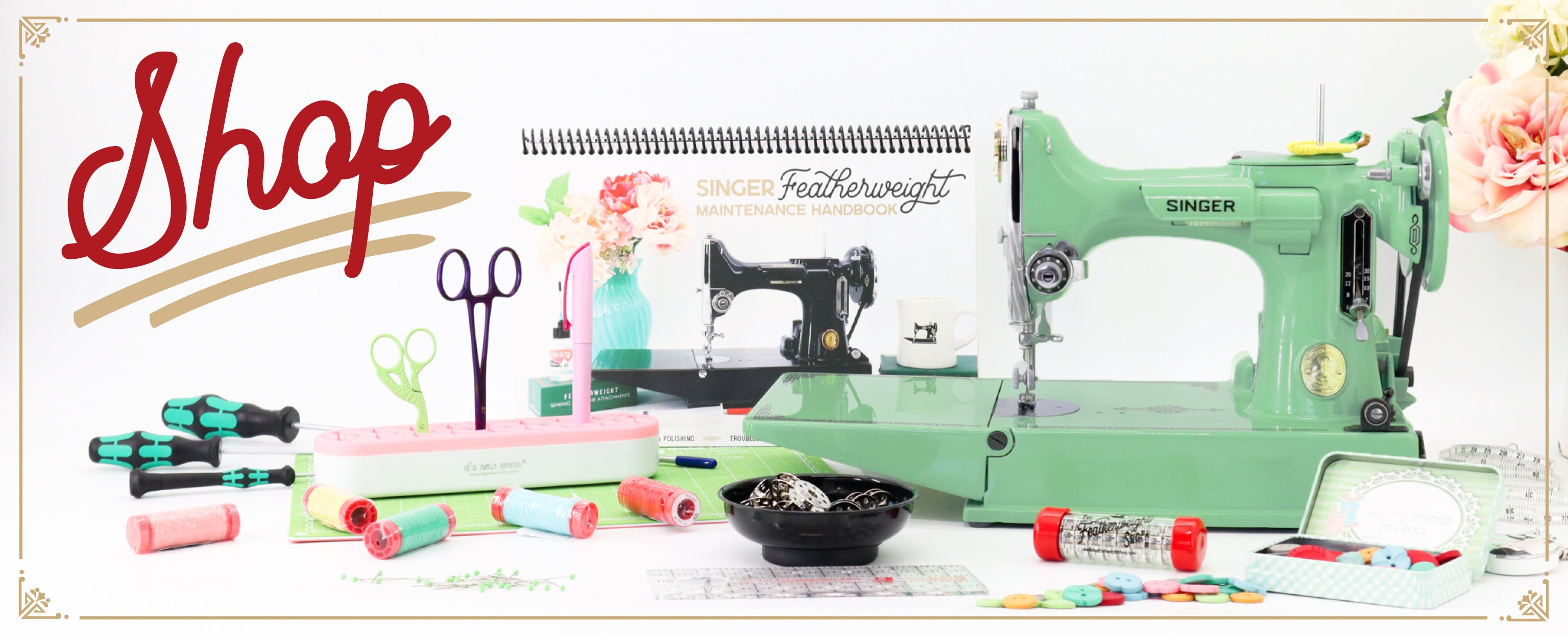Featherweight Embroidery: Part 3 ~ Piecing the Border
I'm Kristen from Verity Vintage Studio who walked you through stitching the beautiful Featherweight 221 counted cross-stitch last year! In the coming weeks, I'm excited to demonstrate the lovely, Featherweight Embroidery - "A Quilter's Dream" Vintage Autumn kit.
Preparing the Embroidery
I got the embroidery all finished this week on my Vintage Autumn Kit! My favorite part was the little spool of thread on top of the machine. It's so cute!



Order "A Quilter's Dream" Featherweight Embroidery Kit in your color preference (Vintage Autumn or Lori Holt Sewing Happy)
Just joining us? Click here to start following along at the very beginning.
Supplies Needed:
- A Quilter's Dream Kit - Vintage Autumn- If it is sold out, you can sign up for the in-stock notification at product link, and you will be notified as soon as we have more kits available.
- 4-inch or 6-inch Embroidery Hoop
- Glass-Head Pins
- Iron
- Sewline Water Erasable Roller Ball Pen
- Embroidery Scissors
- Hand-sewing needles in various sizes
- Needleminder
- The Beekeeper Thread Minder by Lori Holt
- Already have the supplies on hand?
Printed Pattern only is available here.
The next step is to remove all the tracing marks, so I sprayed it well with water. It's always fun to see the blue lines disappear. It makes the whole project look so much tidier too.

At this time you can also remove the basting threads. Then let it dry out at least most of the way.

Once dry (you can hurry it up under a fan if you want), press it thoroughly on both sides. I found that running the tip of the iron between the stitch lines helped smooth out some of the puckers from the embroidery.

Now it needs to be trimmed to the dimensions the pattern calls for. A freezer paper template was recommended, and I agree. It's the only way to get it perfectly centered. You can even crease the freezer paper to mark the center, and use your quilting ruler to make sure the embroidery is centered on each side of the center mark.

Of course, freezer paper is easy to cut through, so you have to be careful when cutting it out. The width dimensions were a half-inch wider than the freezer paper I had, so I just moved my quilting ruler out a quarter inch and lined that up with the edge of the paper before cutting each side.

Half Square Triangles
Now that the embroidery is pressed and trimmed to size, lay it aside. Time to work on the piecing part of this project!
There are more 5” charm squares in a package than you will need, but that gives you extra options.

First choose 8 light and 8 dark charm squares. These are the ones I picked out.

Cut each square in half, then each half in half again so it is in exactly even quarters. You can get 4 of the squares you need from each of the 5” charm squares, though of course, if you want a more scrappy project, you can use more fabric and cut less from each charm square.
To save time, you can layer several charm squares and cut them all at once.


The pattern calls for marking a diagonal line on the back of each light square. Personally, for such small squares, I prefer to eyeball it. It's up to you! But if you do mark the backs of your square, you may need to move the ruler a little over so that your pencil mark hits direct center from tip to tip.
A regular pencil is fine for this since it won't be seen on the right side at all.

Now layer up a light and a dark square, making sure the edges match as exactly as possible, and stitch a diagonal line from tip to tip.

You can chain piece them all at once if you want. Then each square has to be finished individually by trimming about a quarter inch to one side of the seam. You can use a ruler or just trim it more roughly.

When opened and pressed, each square should measure exactly 2½ inches with the diagonal seam down the center like this.

The instructions are quite detailed, so hopefully even if you have no quilting experience, you will find this part easy to do.
Tiny Dresden
The other piecing we need to do this coming week in preparation for finishing the picture is the tiny Dresden appliqué. There is a template included in the pattern. I didn't want to cut the pattern, so I traced it onto some scrap paper and cut that out instead.
Choose more fabric from your remaining charm squares. You can make it scrappy if you want; I decided to alternate two fabrics for mine. So I need to trace the template on the back of each charm square 8 times.

If you nest the side edges, you save time and fabric!

I recommend cutting these out with scissors instead of a rotary cutter.

Now to make the Dresden sections, fold each one in half lengthwise (right sides together) and stitch the top edge. These are super tiny so you have to be careful they don't shift!

Now, using Alex Anderson's 4-in-1 Essential Wooden Sewing Tool, turn the points right side out and press. Once you have made all the sections, they will get stitched together along each side to form a circle.

Now that you know how to make the components, you can take your time this week, piecing all the half-square triangles and making the tiny Dresden.
Next week, we will make the yoyo and do the assembly to get it ready to frame. It will be fun to see it all come together in the end. We're in the home stretch!


Goodbye for now,
Kristen
< Autumn Vintage Part 2 > Autumn Vintage Part 4 >

